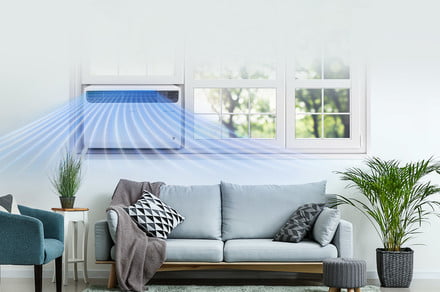Let’s go over important AC features and how portable and window models differ so you know which is the right choice for you. And, if you’d like to take a look at potential models, we have guides for the best smart portable air conditioners and the best window air conditioners you can buy.
Design
It’s important to recognize that both portable and window AC units largely function the same: They use refrigerant to pull in and store heat from nearby indoor air, cooling down rooms and releasing heat and excess moisture into the outdoor air. That remains the same for both options, so their design really comes down to how they are used.
Portable air conditioner units are designed to sit on the floor, and they can come in a wide variety of designs, although most are a towerlike shape, small enough to move around and often equipped with wheels to make repositioning easier. They often must be positioned near a window (more on this below) to run a vent out of to shed excess heat and water vapor outside, but they otherwise have few placement requirements.
Window AC units, on the other hand, are made for a (more or less) permanent installation in a space where a windowpane used to be. This allows them to face outside so they can let heat dissipate into the outdoor air and even connect to a permanent drainage system if necessary. Window air conditioners tend to be standardized in shape, made to fit specific types of windows. This also means that you have to give up window space to use them, which may be more difficult in some cases than others.
Efficiency
Window AC units tend to be larger and more powerful, and research from Appliance Analysts indicates that their coverage gets more reliable as their power increases, up to around 700 square feet (most window AC units can’t easily cool areas larger than this). This is why window air conditioners are the best options for apartments and lofts and why portable AC units can’t really compete with them on an efficiency rating.
It’s also worth pointing out that some window AC units are hybrid models that can switch to a heating mode. This doesn’t make them more efficient, but it does provide more year-round usability that some users may put a high priority on.
Cost
Costs for both portable and window AC units tend to be around $200 to $400 depending on what size of model you are interested in and how many features it has. Portable air conditioners that also have dehumidifier functions and plenty of smarts tend to cost the most and can rise to about $600. Hybrid window models that also offer heating can go even higher.
Installation
A portable air conditioner is designed to be easy to install. When setting it up for use, you connect the AC vent to your nearby window. Often these AC units come with specialized window inserts or panels for a better fit, but not much other installation is needed.
Window AC units, on the other hand, are designed for do-it-yourself installation where they are screwed into the window area, and one of the hardest parts is often just lifting the unit into place. However, if you also have to fully remove a window and don’t really know how to do it, it’s a good idea to schedule a professional installation.
Portability and handling
The portable type of AC unit comes in two different designs, both significantly different, so we wanted to spend a moment discussing this.
The first type uses a vent line that is meant to be run out of a nearby window and to a safe patch of ground. This is a very common type of model that takes some time to set up but can be moved to different rooms as needed and put away for the colder seasons to save room. However, it does require an open window and possibly a hole in window screens, which may raise the risks of letting pests or pollen inside the home (many models have sealing features to help prevent this, but quality can vary). In some cases, this type of model may be connected to a ceiling vent, although this isn’t common in home units.
The second type of portable unit is called a “ventless” unit, aka an evaporative cooler, because it doesn’t require running a temporary vent out of a window. Instead, an evaporative cooler is a fan that also adds cool moisture to the air as water vapor, creating a chilling effect on human skin. It’s an option for offices that don’t have windows that can be opened and similar situations.
Window AC units, of course, aren’t really portable at all. In extreme situations, they can be uninstalled or replaced, but they are generally considered a fixture of the building.
Conclusion
A window-based air conditioner is generally easy to use and a better return for the money unless you really need a portable AC unit. Here are a few situations where a portable model tends to be the better option:
- Windows may be too high off of the ground to comfortably install a window AC, even on the first floor.
- Windows have a shape or style that prevents a window AC from being used.
- You really don’t want to sacrifice the light or airflow you get from your windows.
- There are rules against using a window AC (it sounds strange, but some HOAs or complex rules do mention this).
- As we mentioned, some spaces don’t have access to windows or windows that will open.
- You already have central AC but want on-the-spot cooling for particularly hot areas.
If you aren’t sure what model to get, we suggest contacting a local HVAC expert to discuss the size of your home, what other cooling methods you use, and how much power you need.
Editors’ Recommendations
- Apple AirPlay 2: Here’s everything you need to know
- The best USB-C power adapters, cables, and portable chargers for iPhone 12
- The best Windows apps for 2021
- Best cheap laptop deals for May 2021
- Acer Predator Triton 500 SE hands-on review: A display from the future


